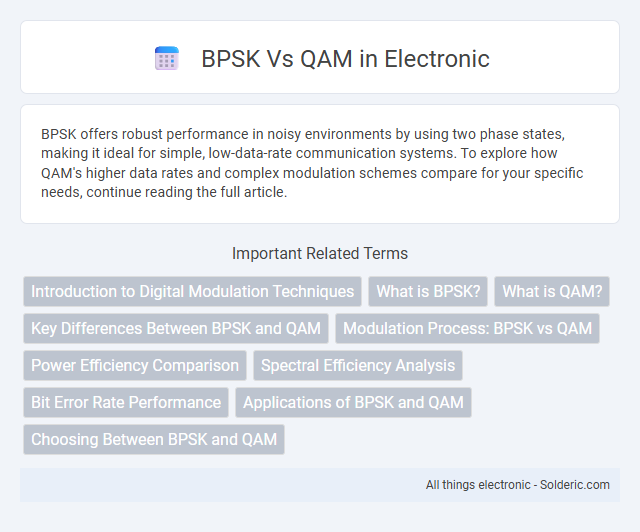BPSK offers robust performance in noisy environments by using two phase states, making it ideal for simple, low-data-rate communication systems. To explore how QAM's higher data rates and complex modulation schemes compare for your specific needs, continue reading the full article.
Comparison Table
| Feature | BPSK (Binary Phase Shift Keying) | QAM (Quadrature Amplitude Modulation) |
|---|---|---|
| Modulation Type | Phase modulation | Amplitude and phase modulation |
| Bits per Symbol | 1 bit | 2 to 12+ bits (e.g., 16-QAM = 4 bits) |
| Bandwidth Efficiency | Low | High |
| Signal Complexity | Simple | Complex |
| Noise Immunity | High (robust in low SNR) | Lower (susceptible to noise) |
| Typical Applications | Satellite links, low data rate wireless | Broadband wireless, digital TV, WiFi |
| Power Efficiency | High | Moderate to Low |
| Complexity of Receiver Design | Low | High |
Introduction to Digital Modulation Techniques
Binary Phase Shift Keying (BPSK) and Quadrature Amplitude Modulation (QAM) are fundamental digital modulation techniques used in wireless communication systems. BPSK modulates digital data by shifting the phase of a constant carrier wave between two states, representing binary 0 and 1, ensuring high noise immunity and simplicity. QAM combines both amplitude and phase variations of the carrier signal to encode multiple bits per symbol, achieving higher spectral efficiency suitable for broadband applications.
What is BPSK?
BPSK (Binary Phase Shift Keying) is a digital modulation scheme that conveys data by shifting the phase of a carrier wave between two distinct values, typically 0deg and 180deg, representing binary digits 0 and 1. It offers high resistance to noise and simple implementation, making it ideal for low data rate transmissions and reliable communication in noisy environments. Your communication system benefits from BPSK's robustness, especially where signal integrity is critical but bandwidth efficiency is less prioritized compared to QAM.
What is QAM?
QAM (Quadrature Amplitude Modulation) combines both amplitude and phase variations to encode data, offering higher data rates compared to BPSK (Binary Phase Shift Keying), which uses phase changes alone. By modulating two carrier waves that are out of phase by 90 degrees, QAM transmits multiple bits per symbol, enhancing spectral efficiency for your communication system. This makes QAM a preferred choice in modern digital communication standards requiring increased bandwidth utilization.
Key Differences Between BPSK and QAM
BPSK (Binary Phase Shift Keying) uses two distinct phase states to represent data, making it robust against noise but limited to transmitting one bit per symbol. QAM (Quadrature Amplitude Modulation) combines both amplitude and phase variations, enabling higher data rates by encoding multiple bits per symbol, such as 16-QAM or 64-QAM formats. Your choice between BPSK and QAM depends on the trade-off between signal resilience and bandwidth efficiency within your communication system.
Modulation Process: BPSK vs QAM
BPSK (Binary Phase Shift Keying) modulates data by shifting the phase of a carrier wave between two distinct states, representing binary 0 and 1 with a phase difference of 180 degrees. QAM (Quadrature Amplitude Modulation) combines amplitude and phase modulation by varying both the amplitude and phase of the carrier signal to encode multiple bits per symbol, increasing spectral efficiency. The modulation process in QAM is more complex, involving two orthogonal carriers modulated in amplitude, allowing higher data rates compared to the simpler phase-only modulation of BPSK.
Power Efficiency Comparison
BPSK (Binary Phase Shift Keying) offers higher power efficiency than QAM (Quadrature Amplitude Modulation) due to its constant envelope and simpler constellation, making it more resilient to non-linear distortion in power-limited scenarios. QAM, while spectrally more efficient by transmitting multiple bits per symbol, generally requires higher signal-to-noise ratio (SNR) and increased power to maintain the same error performance as BPSK. Your choice between BPSK and QAM depends on balancing power constraints against bandwidth efficiency and system complexity.
Spectral Efficiency Analysis
BPSK (Binary Phase Shift Keying) offers low spectral efficiency, transmitting 1 bit per symbol due to its binary nature, making it bandwidth-conservative but less data-dense. QAM (Quadrature Amplitude Modulation), especially high-order variants like 16-QAM or 64-QAM, significantly increases spectral efficiency by encoding multiple bits per symbol through amplitude and phase variations. This higher spectral efficiency of QAM enables greater data rates within the same bandwidth, essential for modern high-throughput communication systems.
Bit Error Rate Performance
BPSK (Binary Phase Shift Keying) generally offers better bit error rate (BER) performance than QAM (Quadrature Amplitude Modulation) at the same signal-to-noise ratio due to its simpler signaling with two distinct phase states. QAM, while providing higher spectral efficiency by transmitting multiple bits per symbol, typically experiences higher BER in noisy environments because of its denser constellation points. Your choice between BPSK and QAM should consider the trade-off between BER performance and data rate requirements for optimal communication system design.
Applications of BPSK and QAM
BPSK (Binary Phase Shift Keying) is widely used in satellite communication, deep-space transmission, and low-speed wireless systems due to its robustness in noisy environments. QAM (Quadrature Amplitude Modulation) is preferred in high-speed data transmission applications like broadband internet, digital cable TV, and 4G/5G cellular networks because of its higher spectral efficiency. Understanding the strengths of BPSK and QAM can help optimize Your communication system design for varying requirements of reliability and data rate.
Choosing Between BPSK and QAM
Choosing between BPSK and QAM depends on your communication system's requirements for data rate and noise resilience. BPSK offers robust performance in noisy environments with simpler implementation but supports lower data rates. QAM provides higher spectral efficiency and increased data rates by transmitting multiple bits per symbol, making it ideal for bandwidth-limited channels with moderate noise levels.
BPSK vs QAM Infographic

 solderic.com
solderic.com